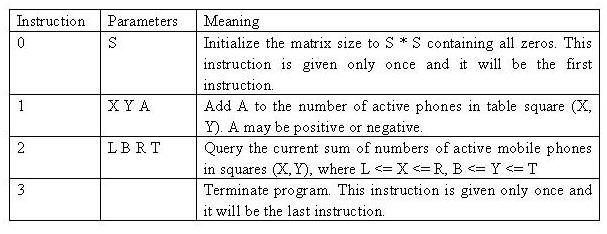POJ 1195 Mobile phones(二维树状数组)
2015-07-09 00:10
218 查看
Mobile phones
Description
Suppose that the fourth generation mobile phone base stations in the Tampere area operate as follows. The area is divided into squares. The squares form an S * S matrix with the rows and columns numbered from 0 to S-1. Each square contains a base station. The
number of active mobile phones inside a square can change because a phone is moved from a square to another or a phone is switched on or off. At times, each base station reports the change in the number of active phones to the main base station along with
the row and the column of the matrix.
Write a program, which receives these reports and answers queries about the current total number of active mobile phones in any rectangle-shaped area.
Input
The input is read from standard input as integers and the answers to the queries are written to standard output as integers. The input is encoded as follows. Each input comes on a separate line, and consists of one instruction integer and a number of parameter
integers according to the following table.

The values will always be in range, so there is no need to check them. In particular, if A is negative, it can be assumed that it will not reduce the square value below zero. The indexing starts at 0, e.g. for a table of size 4 * 4, we have 0 <= X <= 3 and
0 <= Y <= 3.
Table size: 1 * 1 <= S * S <= 1024 * 1024
Cell value V at any time: 0 <= V <= 32767
Update amount: -32768 <= A <= 32767
No of instructions in input: 3 <= U <= 60002
Maximum number of phones in the whole table: M= 2^30
Output
Your program should not answer anything to lines with an instruction other than 2. If the instruction is 2, then your program is expected to answer the query by writing the answer as a single line containing a single integer to standard output.
Sample Input
Sample Output
Source
题意:输入 0 n 表示创建一个n*n的矩阵,初始化为0
输入1 x y v 将点(x,y)的值加上v,如果v小于0,则(x,y)的值最小只能减到0
输入 2 x y x1 y1 求子矩阵(x,y)~(x1,y1)的和
输入3 结束
| Time Limit: 5000MS | Memory Limit: 65536K | |
| Total Submissions: 16320 | Accepted: 7502 |
Suppose that the fourth generation mobile phone base stations in the Tampere area operate as follows. The area is divided into squares. The squares form an S * S matrix with the rows and columns numbered from 0 to S-1. Each square contains a base station. The
number of active mobile phones inside a square can change because a phone is moved from a square to another or a phone is switched on or off. At times, each base station reports the change in the number of active phones to the main base station along with
the row and the column of the matrix.
Write a program, which receives these reports and answers queries about the current total number of active mobile phones in any rectangle-shaped area.
Input
The input is read from standard input as integers and the answers to the queries are written to standard output as integers. The input is encoded as follows. Each input comes on a separate line, and consists of one instruction integer and a number of parameter
integers according to the following table.

The values will always be in range, so there is no need to check them. In particular, if A is negative, it can be assumed that it will not reduce the square value below zero. The indexing starts at 0, e.g. for a table of size 4 * 4, we have 0 <= X <= 3 and
0 <= Y <= 3.
Table size: 1 * 1 <= S * S <= 1024 * 1024
Cell value V at any time: 0 <= V <= 32767
Update amount: -32768 <= A <= 32767
No of instructions in input: 3 <= U <= 60002
Maximum number of phones in the whole table: M= 2^30
Output
Your program should not answer anything to lines with an instruction other than 2. If the instruction is 2, then your program is expected to answer the query by writing the answer as a single line containing a single integer to standard output.
Sample Input
0 4 1 1 2 3 2 0 0 2 2 1 1 1 2 1 1 2 -1 2 1 1 2 3 3
Sample Output
3 4
Source
题意:输入 0 n 表示创建一个n*n的矩阵,初始化为0
输入1 x y v 将点(x,y)的值加上v,如果v小于0,则(x,y)的值最小只能减到0
输入 2 x y x1 y1 求子矩阵(x,y)~(x1,y1)的和
输入3 结束
#include<cstdio>
#include<cstring>
#include<iostream>
#include<algorithm>
#include<cstdlib>
#include<cmath>
#define N 1040
#define ll long long
using namespace std;
int n;
int bit
;
int a
;
ll sum(int i,int j) {
ll s=0;
while(i>0) {
int jj=j;
while(jj>0) {
s+=bit[i][jj];
jj-=jj&-jj;
}
i-=i&-i;
}
return s;
}
void add(int i,int j,int x) {
while(i<=n) {
int jj=j;
while(jj<=n) {
bit[i][jj]+=x;
jj+=jj&-jj;
}
i+=i&-i;
}
}
int main() {
//freopen("test.in","r",stdin);
int op;
while(scanf("%d",&op)) {
if(op==3)break;
if(op==0) {
scanf("%d",&n);
memset(bit,0,sizeof bit);
memset(a,0,sizeof a);
continue;
}
if(op==1) {
int x,y,v;
scanf("%d%d%d",&x,&y,&v);
x++,y++;
if(v<0) {
if(a[x][y]+v<0) {
//a[x][y]=0;
v=-1*a[x][y];
}
}
a[x][y]+=v;
add(x,y,v);
continue;
}
ll ans=0;
int lx,ly,rx,ry;
scanf("%d%d%d%d",&lx,&ly,&rx,&ry);
lx++,ly++,rx++,ry++;
ans=sum(rx,ry)-sum(lx-1,ry)-sum(rx,ly-1)+sum(lx-1,ly-1);
printf("%lld\n",ans);
}
return 0;
}
相关文章推荐
- java.util.Date和java.sql.Date
- SRM 634 #DIV2
- 触摸java常量池
- Kth Smallest Element in a BST
- CodeIgniter学习笔记(七)——CI中的数据库操作
- 在实例中说明java的类变量,成员变量和局部变量
- NABCD需求分析
- Android 自定义DialogFragment替代popupwindow
- ESP8266学习笔记2:实现ESP8266的局域网内通信
- mybatis自动生成工具
- 《Python学习手册》学习笔记——第4章
- laravel 路由
- 堆 在游戏中的运用
- [CodeEdit--Sublime]Sublime热键
- LINUX下date命令的使用方法
- [转]spring整合hibernate配置文件
- Linux Shell 数组的创建及使用技巧
- Shell动态生成数组的多种方法
- Shell中创建序列和数组(list、array)的方法
- Shell时间运算及时间差计算方法
